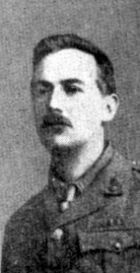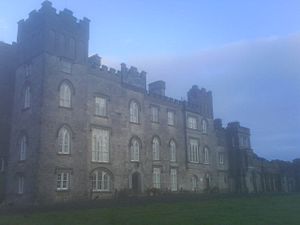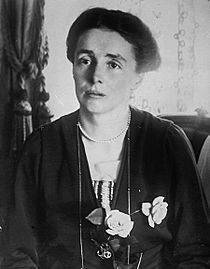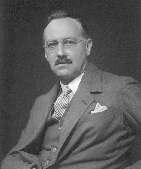Lord Dunsany facts for kids
Quick facts for kids
The Lord Dunsany
FRSL
|
|
|---|---|
| Born | Edward John Moreton Drax Plunkett 24 July 1878 London, England |
| Died | 25 October 1957 (aged 79) Dublin, Ireland |
| Occupation | Writer (short story writer, playwright, novelist, poet) |
| Nationality | Irish, British |
| Genre | Crime, high fantasy, horror, science fiction, weird fiction |
| Notable works | Early short story collections, The King of Elfland's Daughter, The Gods of Pegāna |
Edward John Moreton Drax Plunkett, 18th Baron of Dunsany (born July 24, 1878 – died October 25, 1957), usually known as Lord Dunsany, was a famous Irish writer and playwright. He wrote over 90 books during his lifetime, including stories, essays, poems, and plays. He became well-known in the 1910s for his unique writing style.
Today, he is best known for his 1924 fantasy novel, The King of Elfland's Daughter. His first book, The Gods of Pegāna, is also famous for creating a whole new world with its own gods. Many people think his early stories helped create the modern fantasy genre.
Lord Dunsany was born in London and was the heir to an old Irish noble family. He grew up partly in Kent, England, but mostly lived at Dunsany Castle in Ireland. This castle is one of the oldest continuously lived-in homes in Ireland. He worked with famous writers like W. B. Yeats and Lady Gregory to support the Abbey Theatre in Dublin.
Besides writing, he was also a champion in chess and pistol shooting in Ireland. He loved to travel and enjoyed fox hunting. He even invented his own chess game called Dunsany's chess. Later in life, he received a special degree from Trinity College Dublin. He moved back to Shoreham, Kent, in 1947. In 1957, he became sick while visiting Ireland and sadly passed away in Dublin from appendicitis.
Contents
Biography
Early life and family
Edward Plunkett, known as "Eddie" to his family, was the first son of John William Plunkett, the 17th Baron of Dunsany, and his wife, Ernle Elizabeth.
His family was very old and famous in Ireland. He was related to many well-known Irish people, including Saint Oliver Plunkett, a Catholic saint. He was also related to Sir Horace Plunkett, a politician who worked to improve Ireland.
Edward's mother was a cousin of the famous explorer Sir Richard Burton. From her side of the family, Edward inherited his tall height, being 6 feet 4 inches (193 cm) tall.
Edward grew up in his family's homes, including Dunstall Priory in Shoreham, Kent, and Dunsany Castle in County Meath, Ireland. He also spent time in London. He went to school at Cheam School, Eton College, and the Royal Military College, Sandhurst.
Becoming Lord Dunsany and marriage
Edward became Lord Dunsany when his father died in 1899. He was quite young at the time. After serving in a war, the young Lord Dunsany returned to Dunsany Castle in 1901.
In 1903, he met Lady Beatrice Child Villiers. She was the youngest daughter of the 7th Earl of Jersey. They got married in 1904. Their only child, Randal, was born in 1906. Lady Beatrice was very supportive of Dunsany's writing. She helped him by typing his stories and choosing works for his collections. She also looked after his writings after he passed away.
The Dunsanys were active in society in Dublin and London. They traveled between their homes in Ireland, London, and Kent. They met many famous writers of their time. Lord Dunsany was friends with writers like George William Russell, Oliver St. John Gogarty, and W. B. Yeats. He also spent time with George Bernard Shaw and H. G. Wells, and was a friend of Rudyard Kipling.
In 1910, Lord Dunsany added a two-story part to Dunsany Castle. This new section included a billiard room, bedrooms, and other rooms.
Military service

Dunsany served as a soldier in the Coldstream Guards during the Second Boer War in South Africa. When World War I started, he volunteered and became a Captain in the Royal Inniskilling Fusiliers. He was stationed in Derry for a while.
In 1916, while on leave, he heard about fighting in Dublin during the Easter Rising. He drove there to help and was wounded by a bullet in his head. After getting better in the hospital, he went back to duty. He was later involved in writing materials for the War Office.
During the Irish War of Independence, Dunsany was accused of breaking a rule and was tried by a military court in 1921. He was found guilty and had to pay a fine. This happened after soldiers searched Dunsany Castle and found several guns and ammunition.
During World War II, Dunsany joined the local defense forces in both Ireland and Britain. He was very active in Shoreham, Kent, which was a village often bombed during the Battle of Britain.
Literary life
Lord Dunsany became famous mainly because of his many writings. He was part of the Irish Literary Revival, a time when Irish writers created many important works. He gave a lot of money to the Abbey Theatre and was involved in Irish writing groups. He knew and supported many writers, including W. B. Yeats, Lady Gregory, and Francis Ledwidge.
Dunsany made his first trip to the United States for a speaking tour in 1919. He made more visits until the 1950s, traveling to the East Coast and later to California.
His writing and contributions to Irish literature were recognized when he received a special degree from Trinity College Dublin.
Later years and death
In 1940, Dunsany became a professor of English at Athens University in Greece. He was very successful there. However, he had to leave in April 1941 because of the German invasion of Greece. His long journey home later became the basis for a long poem he published.
In 1947, Dunsany gave his Irish estate to his son and moved to his home in Shoreham, Kent, called Dunstall Priory. He visited Ireland only sometimes after that. He also started new trips to the United States, especially California.
In 1957, Lord Dunsany became ill while having dinner in Ireland. It turned out to be appendicitis. He died in a hospital in Dublin at 79 years old. He was buried in the churchyard of St Peter and St Paul in Shoreham, Kent. Many family members and friends attended his funeral.
His wife, Beatrice, continued to live in Shoreham and looked after his writings until she died in 1970. Their son, Randal, became the next Baron, and then his grandson, Edward Plunkett, who is an artist, took over the title.
Interests and hobbies
Besides writing, Dunsany loved chess. He created chess puzzles for newspapers like The Times and even played a famous chess master, José Raúl Capablanca, to a draw. He also invented his own chess game called Dunsany's Chess, which was unusual because it didn't use any special new pieces. He was the president of the Irish Chess Union and other chess clubs for many years.
Dunsany was also a skilled horseman and hunter. He hosted local hunting groups and hunted in Africa. At one time, he was the pistol-shooting champion of Ireland. He also cared about animal rights and spoke out against practices like cutting dogs' tails. He was the president of a local branch of the RSPCA.
He enjoyed cricket and even provided the land for a local cricket ground in Ireland. Later, he played for and led the Shoreham Cricket Club in Kent. He supported Scouting for many years and was president of the Sevenoaks Boy Scouts Association. He also helped a local amateur drama group.
Writings
Lord Dunsany wrote a lot of short stories, novels, plays, poems, and essays. He published over 90 books during his life, and more than 120 have been released by 2017. His works have been translated into many languages around the world.
Starting his writing career
Dunsany began writing in the late 1890s. His early poems included "Rhymes from a Suburb." In 1905, writing as Lord Dunsany, he published The Gods of Pegāna, which was very well-received.
Early fantasy stories
Dunsany's most famous fantasy short stories came out between 1905 and 1919. At that time, fantasy wasn't even recognized as its own type of writing yet. He paid to publish his first collection, The Gods of Pegāna.
The stories in his first two books were set in a made-up world called Pegāna. This world had its own gods, history, and places. Dunsany often worked with Sidney Sime, an artist who drew pictures for many of his books until 1922.
Plays and drama
After The Book of Wonder (1912), Dunsany started writing plays. Many of these plays were even more successful than his early stories. He continued writing plays for the theater into the 1930s, including the famous If (1921). He also wrote plays for radio.
Some of Dunsany's plays were not meant to be performed live on a stage. These "chamber plays" or "closet dramas" sometimes included magical events, like a character appearing or disappearing without explanation. This didn't matter because Dunsany wrote them to be read, not acted out.
Later works
After a successful speaking tour in the U.S. in 1919–1920, Dunsany became known mostly for his plays. For a while, he wrote fewer short stories and focused on plays, novels, and poetry. His poetry was so popular that a character in a famous novel by F. Scott Fitzgerald even recited it.
Dunsany's first novel, Don Rodriguez: Chronicles of Shadow Valley, came out in 1922. It's set in a magical version of Spain and follows a young nobleman's adventures. In 1924, he published his second novel, The King of Elfland's Daughter, which was more like his early fantasy stories.
One of his most popular characters was Joseph Jorkens. Jorkens was a middle-aged man who loved to tell amazing, unbelievable stories at a club in London, especially if someone bought him a whiskey. From his tales, it seemed Jorkens had traveled everywhere and was very clever, but he never managed to get rich or famous. The Jorkens books were some of the first "club tales," a type of story that became popular in fantasy and science fiction.
Dunsany had some interesting writing habits. His wife, Lady Beatrice, said he always sat on a crumpled old hat when he wrote. He almost never rewrote anything; everything he published was a first draft. He often wrote with a quill pen he made himself. Lady Beatrice was usually the first to read his writings and helped type them.
Writing style and themes
Dunsany's writing style changed a lot during his career. He would often move on to a new style when he felt he had explored one enough. His early fantasy stories were simple and magical. Later, in books like The Book of Wonder (1912), he sometimes made fun of his own grand writing style.
Each of his story collections has a different feel. For example, A Dreamer's Tales has stories that are sad, scary, or even funny. Here's an example from "The Hoard of the Gibbelins" (1912) that shows his style:
The Gibbelins eat, as is well known, nothing less good than man. Their evil tower is joined to Terra Cognita, to the lands we know, by a bridge. Their hoard is beyond reason; avarice has no use for it; they have a separate cellar for emeralds and a separate cellar for sapphires; they have filled a hole with gold and dig it up when they need it. And the only use that is known for their ridiculous wealth is to attract to their larder a continual supply of food. In times of famine, they have even been known to scatter rubies abroad, a little trail of them to some city of Man, and sure enough, their larders would soon be full again.
Even though his style changed, Dunsany's main ideas often stayed the same. Many of his later novels had Irish themes.
Dramatisations and media
Theatre and radio
Most of Dunsany's plays were performed during his lifetime, some many times in different places, including London's West End and Broadway in New York. At one point, five of his plays were running at the same time in New York.
Dunsany also wrote several plays for radio, mostly broadcast by the BBC. He also read his short stories and poems on air.
Television and cinema
Dunsany appeared on early television shows several times. His plays were also adapted for TV. For example, a play called A Night at an Inn was shown on TV in 1949.
The successful 1944 film It Happened Tomorrow was partly based on one of Dunsany's stories. Other short films were made from his stories, like In the Twilight (1970s) and The Pledge (1981). The 2008 film Dean Spanley was adapted from his novella My Talks With Dean Spanley.
Music and audiobooks
Some musicians have been inspired by Dunsany's work. For example, the album Eduardo Bort (1975) was inspired by his story "Idle Days on the Yann". In 1977, two members of the band Steeleye Span recorded an album based on Dunsany's novel The King of Elfland's Daughter.
Many of Dunsany's short stories have been released as audiobooks, especially in Germany.
Video games
Dunsany appears as a character you can play in the 1999 PlayStation game Koudelka.
Awards and honours
Lord Dunsany was a member of many important groups, including the Royal Society of Literature. He was also the President of the Authors' Society and the Shakespeare Reading Society for many years.
He received an honorary doctorate degree from Trinity College Dublin in 1940. He was even nominated for the Nobel Prize in Literature, but the award went to Bertrand Russell instead.
Influences on Dunsany
Many things influenced Lord Dunsany's writing:
- Ancient Greek and Latin works: He studied Greek and Latin, especially Greek plays and the writings of Herodotus, who is called the "Father of History." He once wrote that learning about ancient Greek gods made him feel sad for them, and this feeling stayed with him.
- The King James Bible: He read a lot of the Bible when he was young. He said that for years, no other writing style felt natural to him.
- Dunsany Castle Library: His family's castle had a huge library with books from centuries ago, including classic works and old encyclopedias.
- His father's stories: His father told him tales about ancient Egypt that also influenced him.
- Fairy tales: He was inspired by the fairy tales of the Brothers Grimm and Hans Christian Andersen, as well as the spooky stories of Edgar Allan Poe.
- Rudyard Kipling: He read the works of Rudyard Kipling, especially his stories set in India.
- Irish speech patterns: The way people spoke in Ireland also influenced his writing.
- William Morris: The heroic fantasy stories of William Morris, set in imaginary lands, also affected him.
- Miguel de Cervantes: His 1922 novel Don Rodriguez seems to be inspired by Cervantes' famous book Don Quixote.
- Beethoven's music: Dunsany loved Beethoven's 7th Symphony and even named one of his plays after it.
Writers influenced by Dunsany
Lord Dunsany's unique style and imaginative worlds had a big impact on many other writers, especially in the fantasy and horror genres:
- H. P. Lovecraft: A famous horror writer, Lovecraft was very impressed by Dunsany. Lovecraft's "Dream Cycle" stories and his dark ideas about the universe clearly show Dunsany's influence.
- J. R. R. Tolkien: The author of The Lord of the Rings, Tolkien gave a copy of Dunsany's The Book of Wonder to a helper when he was working on The Silmarillion.
- Neil Gaiman: A modern fantasy writer, Gaiman has said he admires Dunsany's work. Some people see connections between Dunsany's The King of Elfland's Daughter and Gaiman's Stardust.
- Jorge Luis Borges: A famous Argentine writer, Borges included one of Dunsany's short stories in his book Anthology of Fantastic Literature.
- Arthur C. Clarke: The science fiction writer, known for 2001: A Space Odyssey, enjoyed Dunsany's work and wrote letters to him.
- Ursula K. Le Guin: A celebrated fantasy author, Le Guin once joked that Dunsany was the "First Terrible Fate that Awaiteth Unwary Beginners in Fantasy." This was because many young writers tried to copy Dunsany's style, but it was very hard to do well.
Legacy

Lord Dunsany's writings are still protected by copyright. His family manages his literary rights.
His main home, Dunsany Castle, is over 820 years old and can be visited at certain times. Tours usually include the Library, but not the tower room where he often worked. His other home, Dunstall Priory, was sold to new owners. The Dunsany family still owns some land and a cottage in Shoreham village. Lord Dunsany and his wife are buried in the churchyard there.
Many of Dunsany's original writings, like his manuscripts and typed copies, are kept in the family's archive at Dunsany Castle. Scholars can access these materials to study his work. Some of his papers are also held at the Harry Ransom Center in the United States.
A documentary film called Shooting for the Butler was released in 2014. It included interviews with Dunsany's great-grandson, the castle's curator, and scholars who study his work.
|
See also
 In Spanish: Lord Dunsany para niños
In Spanish: Lord Dunsany para niños



